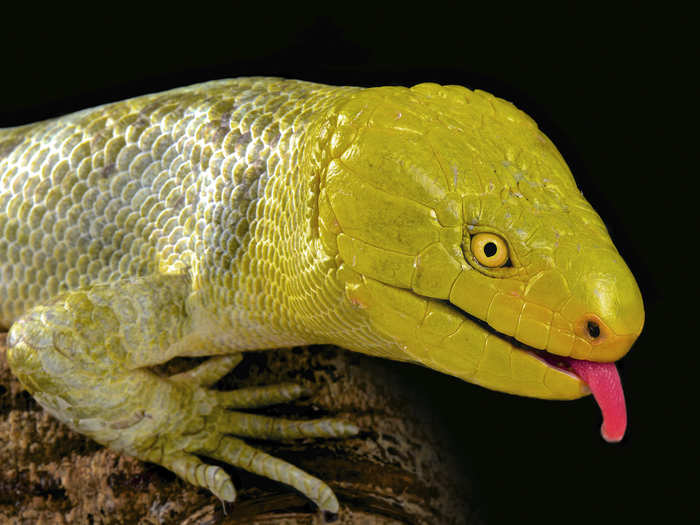
This brilliantly colored yellow skink, a type of lizard, is severely threatened by logging and deforestation. It lives on the Solomon Islands in the Pacific Ocean.

One of those species is this giant bronze gecko (Ailuronyx trachygaster), which was recently rediscovered in the Seychelles, off the east coast of Africa. The International Union for the Conservation of Nature lists the gecko — which Kuijper said hangs out in Coco de mer palm trees — as vulnerable to extinction.

In the image above, he captured the gaze of a Doi Suthep bent-toed gecko, which is native to northern Thailand.

The Paroedura lohatsasara shown here is a critically endangered gecko species. It's native habitat has been reduced to one remaining patch of rainforest in Madagascar, Kuijpers said. The gecko's name comes from the Malagasy words "Loha," which means head, and "tsara," meaning beautiful.

Only male Cameroon dwarf geckos sport polychromatic skin, as shown in this photo. These critters live in western and central Africa.

The Strawberry poison dart frog shown above has strikingly neon colors, and is the most poisonous of its froggy brethren.

This blue poison dart frog is native to the Amazon.

The golden poison dart frog, Phyllobates terribilis, is native to the rainforests of Colombia. It's the largest of the poison dart frogs, and it lives in social groups in the wild.

It's possible that this type of stub foot toad — whose scientific name is Atelopus hoogmoedi nassaui — may have gone extinct since Kuijpers photographed it in 2017.
Source: Fast Company

This black pond turtle, native to south Asia, is listed as vulnerable to extinction. It boasts striking white spots.

The entire population of this gecko lives on a single cliff on Union Island, part of St. Vincent and the Grenadines in the Caribbean. The IUCN lists it as critically endangered.

Only 200 of the Guatemalan bearded lizard pictured above remain in the world. They live in a single valley in Central America, Kuijpers said. The animal has yellow spots on its back and rings on its tail.

The gecko pictured above (Paroedura masobe) is native to Madagascar, and listed as endangered by the IUCN.

The Mangshan pit viper shown here can reach lengths up to 6.5 feet. Native to southeastern China, the venomous snake likes to languish on logs near game trails before ambushing its prey. According to the Saint Louis Zoo, there are reports that this snake can spit venom at would-be predators, like some fellow cobras.

 Tesla tells some laid-off employees their separation agreements are canceled and new ones are on the way
Tesla tells some laid-off employees their separation agreements are canceled and new ones are on the way Taylor Swift's 'The Tortured Poets Department' is the messiest, horniest, and funniest album she's ever made
Taylor Swift's 'The Tortured Poets Department' is the messiest, horniest, and funniest album she's ever made One of the world's only 5-star airlines seems to be considering asking business-class passengers to bring their own cutlery
One of the world's only 5-star airlines seems to be considering asking business-class passengers to bring their own cutlery The Future of Gaming Technology
The Future of Gaming Technology
 Stock markets stage strong rebound after 4 days of slump; Sensex rallies 599 pts
Stock markets stage strong rebound after 4 days of slump; Sensex rallies 599 pts
 Sustainable Transportation Alternatives
Sustainable Transportation Alternatives

Copyright © 2024. Times Internet Limited. All rights reserved.For reprint rights. Times Syndication Service.